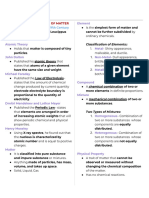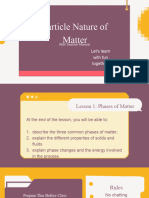Matter Atoms and Isotopes
Matter Atoms and Isotopes
Uploaded by
Kim MingoCopyright:
Available Formats
Matter Atoms and Isotopes
Matter Atoms and Isotopes
Uploaded by
Kim MingoOriginal Title
Copyright
Available Formats
Share this document
Did you find this document useful?
Is this content inappropriate?
Copyright:
Available Formats
Matter Atoms and Isotopes
Matter Atoms and Isotopes
Uploaded by
Kim MingoCopyright:
Available Formats
lOMoARcPSD|40713135
Matter, Atoms and Isotopes
Pharmaceutical Inorganic Chemistry with Qualitative Analysis (Our Lady of Fatima
University)
Scan to open on Studocu
Studocu is not sponsored or endorsed by any college or university
Downloaded by Kim Mingo (mingokimp@gmail.com)
lOMoARcPSD|40713135
Pharmaceutical Inorganic Properties of Matter y
Chemistry with Qualitative Extrinsic Property Intrinsic Property
Analysis physical properties of properties of matter
Week Two, Module 2a and 2b matter which may vary which are constant
from time to time
2a. Matter
not the characteristics of give the characteristics of
Unit Outline the substance itself the substance its unique
identity
I. Definition of Matter
II. Properties of Matter depends on the amount do not depend on the
III. Classifications of Matter amount
IV. Changes in Matter amount = extensive
V. States of Matter properties. amount = intensive
properties
Definition of Matter y Examples: height, weight, Examples: boiling point,
temperature, size, shape, freezing point, melting
Matter volume, etc. point, viscosity, refractive
● anything that occupies space and has mass index, etc.
● all matter has volume: amount of space taken up by
something and weight. Extrinsic Property
● there’s always volume when something occupies ● quantitative
space ● Ex: water in a tumbler. The extrinsic property of
● matter comes in different forms or states water is its volume, since pwede mag-iba.
1. Solid
2. Liquid Intrinsic Properties
3. Gas ● qualitative
● Sometimes matter cannot be seen or felt but it’s ● Ex: water in a tumbler. The intrinsic property of the
there, like gas. water in a tumbler is its boiling point, kahit maging
kaunti ang water sa tumbler constant na ang boiling
Mass Weight point ay 100°
Constant at any place and Varies depends on the Classifications of Matter y
time amount of gravity
Refers to the amount of Refers to the downward
the substance pull of the objects towards
the center of the earth
When travelled to the When travelled to the
moon, the mass of an moon, the weight of an
object will still be the same. object will only be ⅙ of its
weight on earth.
Can never be zero Can also be zero
Mass
● cannot be changed - it is what it is.
● same number of molecules wherever
Weight
● changes depende kung nasaan and sa gravity pull
ng lugar
● the stronger the gravity = the heavier the weight
● can be zero because there are places na walang
gravity
Downloaded by Kim Mingo (mingokimp@gmail.com)
lOMoARcPSD|40713135
I. Pure Substance [ classifications according to elements involved in the
● kind of matter possessing definite, fixed, compound ]
and unvarying composition with unique set
of properties. b.4 Organic compound
● made up of only one kind of matter ➢ carbon containing compound
● walang kahalo - water
b.5 Inorganic compound
a. Elements ➢ no chained carbons
● simplest form of substance that cannot
be decomposed by chemical means ★ b.5.1 Acids - contains hydrogen
● building blocks of matter Ex. HCl, H2SO4, HNO3
● one single element (nasa unahan yung H)
● Ex. Sodium & Chlorine
★ b.5.2 Bases - contains metal + OH
a.1 Metals (hydroxide)
➢ elements characterized by their brilliant Ex. KOH, NaOH, Ca(OH)2
luster, ductility, malleability, and are good (slippery, used for making soaps)
conductors of heat and electricity
➢ Ex: Aluminum foil ★ b.5.3 Salts - combination of any + ion
(except H) and - ion (except OH)
a.1 Non-metals Ex: Na+ + Cl- = Salt
➢ possess the characteristics opposite of H+ + Cl- = Hydrochloric Acid
metals Na+ + OH- = Sodium hydroxide
➢ not malleable - brittle
➢ Ex: Charcoal, Carbon, Wood ★ b.5.4 Oxide - consists of oxygen and other
elements
a.1 Metalloids Ex: ZnO, CaO
➢ elements which possess the
characteristics of both metals and II. Mixtures
nonmetals (in-between) ● composed of two or more substances not
chemically combined
b. Compounds
a. Homogeneous
● pure substance whose molecules are ● 1, 1 phase system, no separation or
made up of two or more kinds of atoms layers. isa lang itsura ng mixture
combined in definite proportions ● Ex: Water with Alcohol
● definite proportion: NaCl (1 sodium, 1
chlorine = salt. If may mababago na b. Heterogeneous
element, not salt anymore) ● 2 or more, 2 phase system, has
● pinagsamang elements separation, distinction and layers
● Ex. NaCl / salt. ● Ex: Oil with water
[ classifications according to formed bonds ] Types of Mixtures
b.1 Ionic compound [HOMO]
➢ has ionic bond 1. Solutions
➢ ionic bond happens if one element
transfers electron to another element [HETERO]
➢ metal + non metal 2. Colloids - small distinction
Ex: Toothpaste, Mayonnaise, Milk (there’s still
b.2 Covalent compound distinction since they can still be separated)
➢ has covalent bond
➢ covalent bond happens because of sharing 3. Suspension - solid + liquid na hindi humahalo or
of electrons soluble with each other
➢ non metal + non metal Ex: Flour + Oil
b.3 Metallic compound 4. Emulsions- liquid + liquid na hindi humahalo or
➢ involves metals soluble with each other
Ex: Water and Oil
Downloaded by Kim Mingo (mingokimp@gmail.com)
lOMoARcPSD|40713135
Differences between Compounds and Mixture r Changes in Matter r
1. Physical Change
Compounds Mixtures
● change in the physical properties of substances
Always have definite Components may be without changing its chemical composition
composition by weight present in any ● no new substance is produced, although there
proportions may be a change in state or density or both
Preparation shows It is prepared with no
evidence of chemical evidence of any chemical Substance Process Accompanying changes
action taking place reaction taking place Involved
Components can be Components do not lose Water Evaporation When liquid change to gas
separated by chemical identity
means Paper Tearing Change in size and shape
Constituents can be Components may be Dress Folding Change in size and shape
separated by chemical separated by mechanical
means means Chalk Pounding Change in size and shape
Composed of two or more Composed of two or more Hair Cutting Change in size and shape
substances that are substances that are not
chemically combined chemically combined
Water - even if vapor or ice, still H2O
Compounds 2. Chemical Change
● one substance but two elements with chemical ● change in the chemical composition and
means, di na pwede paghiwalayin (only by chemical constitution of the substance forming new
means) substance
● original identity of the substance and its properties
Mixtures are altered
● two substances with no chemical reaction, so ● change in which at least one substance change
pwede pa paghiwalayin mechanically composition
● Ex: cooked meat > not capable of being raw again
as chemical change already took place.
Methods of Separating Mixtures r
1. Filtration Substance Process Accompanying changes
Involved
● uses the filtration set-up
● includes filter paper, funnel, iron ring, and iron stand Iron Rusting When the metal changes its
● works with particles that are significantly different in color from bright to reddish
size, sand, and rock with water. brown
2. Distillation Pig’s meat Cooking The meat tenderizes and
● used if two liquids are mixed but have different changes its structures
boiling points
Wine Fermentation When the fruit juice with the
aid of an enzyme from yeast
3. Centrifugation changes to ethyl alcohol and
● processes rely on densities. carbon dioxide (CO2)
● centrifuge : fast revolution to separate
● separates constituents by difference in their weights
through speed because of density
General Properties of the States of Matter r
● settles below
4. Sedimentation States of Shape Volume Examples
● also density, but no need for speed Matter
● faster to settle than centrifugation
● happens when particles of different densities have Solid Definite Definite Tables, chairs,
settled within a liquid rocks, pen
● kung ano mas mabigat yun yung nags-settle sa
Liquid Indefinite Definite Water, alcohol,
ibaba gasoline
Gas Indefinite Indefinite Air, steam
Plasma a gas at a very high temperature but the
particles carry electrical charges
Downloaded by Kim Mingo (mingokimp@gmail.com)
lOMoARcPSD|40713135
A. Solids Dalton Atomic Theory by John Dalton r
1. Rigidity, hardness, and mechanical strength 1. Elements are composed of extremely small
2. Definite size, shape, and volume particles called atoms.
3. Exerts vapor pressure 2. All atoms of a given element are identical, having
4. Sublimation the same size, mass, and chemical properties. The
atoms of one element are different from the atoms
B. Solids of all other elements.
3. Law of Definite Proportion - Compounds are
1. Definite volume, indefinite shape, follows the shape composed of atoms of more than one element. In
of the container any compound, the ratio of the numbers of atoms of
2. Constant boiling points (100) any two of the elements present is either an integer
3. Viscosity or a simple fraction.
4. Evaporation 4. A chemical reaction involves only the separation,
5. Vaporization combination, or rearrangement of atoms; it does not
6. Volatility result in their creation or destruction.
7. Surface tension - tension in between the air and
the liquid. repels the thing sa ibabaw, kaya we can Modern Atomic Theory r
make lutang. [weight ng nakalutang vs. surface
tension of the liquid, dapat talo sa surface tension 1. Atoms may disintegrate. In nuclear reactions, atoms
para makalutang] are being transferred into atoms of single elements
8. Density > mass vs. volume in a process known as nuclear transmutation.
(pwede dagdagan or bawasan ng proton or neutron ang
C. Gas atom)
Nuclear Transmutation = used for radiopharmaceuticals.
1. No definite shape, size, and volume 2. Not all atoms of any given element are alike.
2. Expands when heated 3. Not all atoms of a given element pose identical
3. Exerts pressure properties except in mass.
4. High compressibility - easy to compress because 4. Atoms of different elements have different
malaki space properties.
5. Diffusibility
Structure of Atoms r
D. Plasma
1. Electrons
1. Uses ● Discovered by Joseph John Thompson
● best electrical conductor ● first component of atom to be identified
−31
● consists of ionized gases ● Mass: 9. 109 × 10 𝑘𝑔
−19
● Charge: − 1. 602 × 10 𝑐𝑜𝑢𝑙𝑜𝑚𝑏𝑠
2. General methods to produce plasma
● ^ negatively charged
● cascade process
● thermal ionization process
2. Protons
● Discovered by Eugene Goldstein
● one of the components of a nucleus
2b. Atoms and Isotopes −27
● Mass: 1. 673 × 10 𝑘𝑔
−19
● Charge: + 1. 602 × 10 𝑐𝑜𝑢𝑙𝑜𝑚𝑏𝑠
Unit Outline ● ^ positively charged
● nuclear model: Ernest Rutherford
I. History of Atoms
II. Dalton’s Atomic Theory
3. Neutrons
III. Modern Atomic Theory
IV. Structure of the Atom ● Discovered by James Chadwick in 1932
V. Atomic Number ● another component of nucleus
VI. Mass Number ● Mass: 1. 675 × 10 𝑘𝑔
−27
VII. Isotopes
● ^ has no charge , since charge is already
balanced inside the atom. (charge of
History of Atoms r protons and electron)
Democritus (460-370 BC)
● ‘atomos’, ‘discontinuous matter’, ‘indivisible’
Plato and Aristotle
● “there can be no ultimately indivisible particles”
● everything is made up of 4 elements: air, water, fire,
and earth.
Downloaded by Kim Mingo (mingokimp@gmail.com)
lOMoARcPSD|40713135
Atomic Number r Isotopes r
● number of protons in the nucleus of an atom of ● atoms of the same element with the same atomic
an element, also the number of electrons in an number, but different mass numbers.
atom. ● changes in mass numbers are due to changes in
● this quantity is fundamental to the identity of each number of neutrons.
element because it is related to the electrical make ● In other words, they have the same number of
up of an atom, therefore: protons and electrons but different with
● atomic number = # of protons = # of electrons neutrons.
● Many elements exist as two or more stable
Mass Number r isotopes, although one isotopes is usually present
in greater abundance than another isotopes.
● total number of protons and neutrons on the
nucleus of nucleons, therefore:
● mass number = # of protons + # of neutrons
Nuclear Notation
● A - Mass number
● N - Neutrons
● Z - Atomic number / Protons /
Electrons
Downloaded by Kim Mingo (mingokimp@gmail.com)
You might also like
- Properties of Matter Notes Grade 8Document1 pageProperties of Matter Notes Grade 8Maristela Paraan MacaranasNo ratings yet
- PhysicalPropertiesGuidedNotesEdited PDFDocument7 pagesPhysicalPropertiesGuidedNotesEdited PDFGabriel LouimaNo ratings yet
- What Are Physical Properties of Matter?Document32 pagesWhat Are Physical Properties of Matter?Tomasian100% (3)
- CHM01 RevDocument17 pagesCHM01 RevDaphne DimamayNo ratings yet
- CHM1 11 - 12 Q1 0102 FDDocument22 pagesCHM1 11 - 12 Q1 0102 FDVincent NNo ratings yet
- General Chemistry Notes (Midterms)Document7 pagesGeneral Chemistry Notes (Midterms)John Henry PahilangaNo ratings yet
- 12 STM 005Document4 pages12 STM 005mavelmaxvelNo ratings yet
- Some Basic Concepts of Chemistry 11th NotesDocument10 pagesSome Basic Concepts of Chemistry 11th NotesRʌĸɘsʜ Gɘʜɭot100% (1)
- 4.1 Physical and Chemical PropertiesDocument11 pages4.1 Physical and Chemical PropertiesSarah ANo ratings yet
- CHM01Document17 pagesCHM01Daphne DimamayNo ratings yet
- GC1-chapter 01Document70 pagesGC1-chapter 01Heidi CotillionNo ratings yet
- Chapter 1Document19 pagesChapter 1lelouchali1234No ratings yet
- Gen Chem Week 1 Properties of Matter and Its Various FormsDocument84 pagesGen Chem Week 1 Properties of Matter and Its Various FormsLeonard SalvacionNo ratings yet
- MasterClass GeneralChemistry UniValle Week1Document31 pagesMasterClass GeneralChemistry UniValle Week1anamariavilla08052006No ratings yet
- Matter and Its Properties: Physical Science Week 3 HandoutsDocument2 pagesMatter and Its Properties: Physical Science Week 3 HandoutsBenj Jamieson DuagNo ratings yet
- Concepts About MatterDocument45 pagesConcepts About MatterTrista CincoNo ratings yet
- Properties of MatterDocument13 pagesProperties of MatterJelly Ann M. SalesNo ratings yet
- Chapter 1 NotesDocument8 pagesChapter 1 NotesBlaster OneNo ratings yet
- MatterDocument40 pagesMatterMarianne B. HingpesNo ratings yet
- 7 - State of MatterDocument20 pages7 - State of Matterbdrklaby1No ratings yet
- 2024 - Week - 2 - States of Matter and PropertiesDocument22 pages2024 - Week - 2 - States of Matter and Propertieskarokamil243No ratings yet
- TPNM Intro KCLVMDocument17 pagesTPNM Intro KCLVMEddiezr B de BorjNo ratings yet
- CHAPTER 1 Matter, MeasurementsDocument23 pagesCHAPTER 1 Matter, MeasurementsRusher SigueNo ratings yet
- Worksheet QuestionsDocument4 pagesWorksheet QuestionsNoori ShaikNo ratings yet
- General Chemistry 1 - Module 1 (Ryah Lyn Revale 12 Stem Pasteur)Document4 pagesGeneral Chemistry 1 - Module 1 (Ryah Lyn Revale 12 Stem Pasteur)Ryah Lyn RevaleNo ratings yet
- Bab 5 Tingkatan 1Document14 pagesBab 5 Tingkatan 1foryourhonour wongNo ratings yet
- PS Lesson 3Document2 pagesPS Lesson 3euginNo ratings yet
- General Chemistry 1 Week 1 DiscussionDocument7 pagesGeneral Chemistry 1 Week 1 Discussionpiatot6245No ratings yet
- Chemistry DeebhaDocument27 pagesChemistry DeebhaRicky MartinNo ratings yet
- Physical Properties of MatterDocument14 pagesPhysical Properties of MatterSoso Anoos100% (1)
- 1 Quarter 1 Week 1.1: General ChemistryDocument8 pages1 Quarter 1 Week 1.1: General ChemistryPrince Al-hafidz VillaflorNo ratings yet
- Example: Sun or Any StarDocument3 pagesExample: Sun or Any StarNiki KevinNo ratings yet
- 1st Q 1st TopicDocument43 pages1st Q 1st TopicAlexandra TabucanonNo ratings yet
- Lesson1 Basic Concepts About MatterDocument5 pagesLesson1 Basic Concepts About MatterJayde Bernard RamosNo ratings yet
- Gen Chem1-Week1Document58 pagesGen Chem1-Week1llamasballsNo ratings yet
- Matter and Its NatureDocument5 pagesMatter and Its NatureYogendra VarmaNo ratings yet
- Measurements UnitsDocument85 pagesMeasurements UnitsBisrateab FekaduNo ratings yet
- Qualitative Chemistry 1 - 2023Document16 pagesQualitative Chemistry 1 - 2023modimoratilemNo ratings yet
- GEN CHEMISTRY 1 1stDocument4 pagesGEN CHEMISTRY 1 1strenmarseyerNo ratings yet
- Lesson 1b Week 1intro To Chem Properties of MatterDocument24 pagesLesson 1b Week 1intro To Chem Properties of MatterJohn Mark Loredo FayoNo ratings yet
- MatterDocument34 pagesMatterJimarie CarilNo ratings yet
- CHEMISTRYDocument4 pagesCHEMISTRYGeorgia LanuzoNo ratings yet
- Week 1 - 2 - Properties of MatterDocument53 pagesWeek 1 - 2 - Properties of MatterAngelica Marie ZamoraNo ratings yet
- 05 - SPSF1 07 B5Document14 pages05 - SPSF1 07 B5Anonymous RfKC0LciBK0% (1)
- 05 - SPSF1 07 B5Document14 pages05 - SPSF1 07 B5intan rohaidaNo ratings yet
- Orginorgchem Midterm NotesDocument22 pagesOrginorgchem Midterm NotesJayde Bernard RamosNo ratings yet
- Chapter 1 - Chapter 2Document4 pagesChapter 1 - Chapter 2api-19624513No ratings yet
- Chemistry ReviewerDocument10 pagesChemistry Reviewerapi-19624513No ratings yet
- Unit 5. Matter and MaterialsDocument8 pagesUnit 5. Matter and Materialsjosect2No ratings yet
- Properties of Matter Lesson 1Document39 pagesProperties of Matter Lesson 1mika3laac0sta14No ratings yet
- Introduction To ChemistryDocument19 pagesIntroduction To ChemistryDianne Mae CañeteNo ratings yet
- Unit 9 Particle Nature of MatterDocument67 pagesUnit 9 Particle Nature of Mattermiguelcastillo212301No ratings yet
- CHEMICAL TECHNICIAN EXAM REVIEW: GENERAL CHEM - Introduction To ChemistryDocument2 pagesCHEMICAL TECHNICIAN EXAM REVIEW: GENERAL CHEM - Introduction To ChemistryPrisca Barrientos LimbagNo ratings yet
- Chapter 5 Matter in NatureDocument1 pageChapter 5 Matter in NatureYuhannNo ratings yet
- 1 Matter and Its Properties ...Document65 pages1 Matter and Its Properties ...Akira SatoūNo ratings yet
- General ChemistryDocument5 pagesGeneral ChemistrydionisiocristiandianNo ratings yet
- Chemistry Notes Pero Sakit Na MataDocument1 pageChemistry Notes Pero Sakit Na MataGalino Julia Cristine A.No ratings yet
- Q1 Chemistry ReviewerDocument6 pagesQ1 Chemistry ReviewerEyshiNo ratings yet
- Children Encyclopedia Chemistry: The World of KnowledgeFrom EverandChildren Encyclopedia Chemistry: The World of KnowledgeRating: 5 out of 5 stars5/5 (3)
- Problem Set 1Document1 pageProblem Set 1Hazell SangalangNo ratings yet
- Atoms, Molecules & Stoichiometry: Chemistry As LevelDocument4 pagesAtoms, Molecules & Stoichiometry: Chemistry As LevelArda RahmainiNo ratings yet
- Module2a Science7 (Q1)Document12 pagesModule2a Science7 (Q1)Jonnah Faye MojaresNo ratings yet
- EM24-001-P - Evermin - Morocco ZNPB Bulk Conc - 209,92 WMT Contract Last VersionDocument5 pagesEM24-001-P - Evermin - Morocco ZNPB Bulk Conc - 209,92 WMT Contract Last VersionSalamat KhadijaNo ratings yet
- Use of SO2 As Reducing Agent in Cobalt Leaching PDFDocument4 pagesUse of SO2 As Reducing Agent in Cobalt Leaching PDFrubcarvNo ratings yet
- HKALE Mock Paper II (2010)Document14 pagesHKALE Mock Paper II (2010)tiffany5No ratings yet
- Ss1 Chem Summer WK 3Document4 pagesSs1 Chem Summer WK 3sulaiman mohammedNo ratings yet
- Thermodynamic and Kinetic Aspects of Metal ComplexesDocument27 pagesThermodynamic and Kinetic Aspects of Metal ComplexesWiratama NugrohoNo ratings yet
- ACTIVITY 1-3 Notes Lab OrgchemDocument7 pagesACTIVITY 1-3 Notes Lab OrgchemJaden GonzagaNo ratings yet
- ABC CompoundDocument164 pagesABC CompoundcabangonjasselNo ratings yet
- Part 1 Chapter 3 - Mass Relationships in Chemical ReactionsDocument44 pagesPart 1 Chapter 3 - Mass Relationships in Chemical ReactionsaltheabarlisNo ratings yet
- (@bohring - Bot × @JEE - Tests) AITS-2324-FT-VII-JEEM-SolDocument17 pages(@bohring - Bot × @JEE - Tests) AITS-2324-FT-VII-JEEM-SoldivyanshNo ratings yet
- To UN Kimia SMA DKI 2018 (Pak-Anang - BlogspotDocument14 pagesTo UN Kimia SMA DKI 2018 (Pak-Anang - BlogspotMuhammad Azmi Zaki Mas'udNo ratings yet
- Ritik Mishra Assignment 1 - 23BCE10850Document4 pagesRitik Mishra Assignment 1 - 23BCE10850ritikmis16No ratings yet
- Synthesis and Characterization of New Complex Salts, of Some Transition and Non-Transition Metals With Isoquinolinium Derivative SaltsDocument7 pagesSynthesis and Characterization of New Complex Salts, of Some Transition and Non-Transition Metals With Isoquinolinium Derivative SaltsIJRRRNo ratings yet
- Chapter 2 Acid - Base - EngDocument98 pagesChapter 2 Acid - Base - Englong.vuongbz188No ratings yet
- Dalton's Atomic Theory (Article) - Khan AcademyDocument18 pagesDalton's Atomic Theory (Article) - Khan AcademySheena Shane CantelaNo ratings yet
- Valence Electrons and Valency of An ElementDocument5 pagesValence Electrons and Valency of An ElementManickam GnanashekaranNo ratings yet
- Inorganic ChemistryDocument80 pagesInorganic ChemistryRajeswari Raji100% (1)
- Biochemistry 9th Edition Campbell Test BankDocument24 pagesBiochemistry 9th Edition Campbell Test BankSheilaClarktofa100% (53)
- US20140314874A1Document2 pagesUS20140314874A1cloude21No ratings yet
- Jan 2023 PDFDocument29 pagesJan 2023 PDFMohamed TarekNo ratings yet
- 2023 Collection of Tests KROK 1 NEWDocument162 pages2023 Collection of Tests KROK 1 NEWPavlo TvNo ratings yet
- Cbse Xii Chemistry Project Sterilization of Water Using Bleaching PowderDocument17 pagesCbse Xii Chemistry Project Sterilization of Water Using Bleaching PowderAmriteshbhaskarNo ratings yet
- Pixl Independence:: Chemistry - Student Booklet Ks5Document19 pagesPixl Independence:: Chemistry - Student Booklet Ks5saadNo ratings yet
- Salt Analysis I - Lead Acetate - (Ch3coo) 2pb-1Document28 pagesSalt Analysis I - Lead Acetate - (Ch3coo) 2pb-1YashikNo ratings yet
- Physics IGCSE Past PaperDocument16 pagesPhysics IGCSE Past Paperjenny1004No ratings yet
- Atomic Structure: Defining The AtomDocument2 pagesAtomic Structure: Defining The Atomvincent limNo ratings yet
- Chem 112A Homework D KeyDocument13 pagesChem 112A Homework D KeyShyam Bhakta100% (1)
- MS Paper 1A and BDocument10 pagesMS Paper 1A and Bamankothari2007No ratings yet
























































































